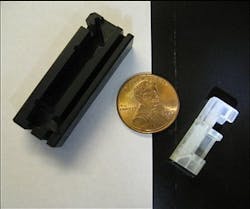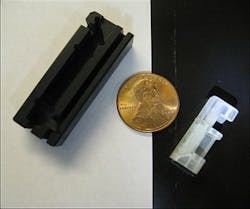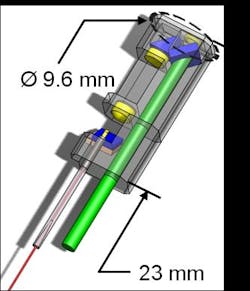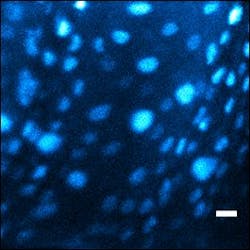Femtosecond probe with 'lightsaber'-like precision promising for laser surgery
Researchers from the University of Texas at Austin (Austin, TX) have developed a small, flexible endoscopic medical device fitted with a femtosecond laser "scalpel" that can removeâwith 'lightsaber'-like precisionâdiseased or damaged tissue without touching healthy cells.
The device, engineered with off-the-shelf parts, pairs a laser that generates 200 fs pulses with a mini-microscope that provides precise control for highly delicate surgery. Using two-photon fluorescence, the microscope relies on infrared (IR) light that penetrates up to 1 mm into living tissue, allowing individual cells or even cell nuclei to be imaged.
The entire endoscope probe, which is thinner than a pencil and less than 1 in long (9.6 mm in circumference and 23 mm long), can fit into large endoscopes, such as those used for colonoscopies. What's more, the probe is functional, feasible, and can be manufactured commercially, says Adela Ben-Yakar of the University of Texas at Austin, the project's principal investigator.
The new system is five times smaller than the team's first prototype and boosts the imaging resolution by 20%, says Ben-Yakar. The optics consist of commercial lenses, a specialized fiber to deliver the ultrashort laser pulses from the laser to the microscope, and a 750 µm micro-electro-mechanical systems (MEMS) scanning mirror. To hold the optical components in alignment, the team designed a miniaturized case fabricated using 3D printing, in which solid objects are created from a digital file by laying down successive layers of material.
Tabletop femtosecond lasers are already in use for eye surgery, but Ben-Yakar sees many more applications inside the body. These include repairing the vocal cords or removing small tumors in the spinal cord or other tissues. Ben-Yakar's group is currently collaborating on two projects: Treating scarred vocal folds with a probe tailored for the larynx, and nanosurgery on brain neurons and synapses and cellular structures such as organelles.
The new design has so far been laboratory-tested on pig vocal chords and the tendons of rat tails, and an earlier prototype was laboratory-tested on human breast cancer cells. The system is ready to move into commercialization, says Ben-Yakar. However, the first viable laser scalpel based on the team's device will still need at least five years of clinical testing before it receives FDA approval for human use, Ben-Yakar adds.
The researchers will present their work at this year's Conference on Lasers and Electro Optics (CLEO: 2012; San Jose, CA): Presentation ATh1M.3, "9.6-mm diameter femtosecond laser microsurgery probe," will take place at 8:45 a.m. on Thursday, May 10.
-----
Follow us on Twitter, 'like' us on Facebook, and join our group on LinkedIn
Follow OptoIQ on your iPhone; download the free app here.
Subscribe now to BioOptics World magazine; it's free!



